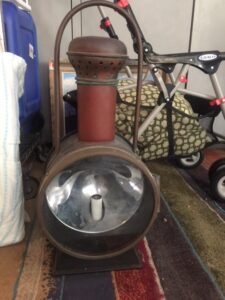 CS sent me a recent find at the wonderful Destined for Grace Thrift Store in Goleta. A 19th century Nautical Oil lamp that somebody electrified. The story of her lamp tells the story of the “mirror of light,” or the catoptric (the Greek word for “mirror/reflection”) system of illumination.
CS sent me a recent find at the wonderful Destined for Grace Thrift Store in Goleta. A 19th century Nautical Oil lamp that somebody electrified. The story of her lamp tells the story of the “mirror of light,” or the catoptric (the Greek word for “mirror/reflection”) system of illumination.
This system “throws” light by means of reflections off a polished metal parabolic surface. Sounds easy? A reflection behind a light source hits a polished parabola shape, concentrates the light, allows the light to spread in a wider arc than light “thrown” by a flat or circular surface.
The Problem and a Solution
How does one handcraft a sheet of polished metal into a parabolic shape? Inventors made attempts in the 17th and early 18th century to hammer copper, cast steel, plate silver over metal. Not until William Hutchinson developed a mosaic of faceted glass mirrors applied to a parabolic surface in 1763 did a functional system exist. Hutchinson let the nautical world know in his book A Treatise on Practical Seamanship of 1777, which revolutionized nautical lighting, especially the construction of lighthouses.
The seafaring world now possessed functioning reflector system, via the mosaic of mirrors in a parabolic shape, to concentrate a light source. Now we needed a functioning light source, something more efficient than early oil lamps, and better than candles. Enter the Argand lamp of 1780. Two inventions not designed to enable the other came as a phenomenon in history! Yet they seem MADE to happen together. Aime Argand’s lamp employed a hollow wick, the shape of a sleeve, inside a circular glass chimney. What fuel? On a ship, whale, or seal oil.
The photo of CS’s lamp doesn’t show the oil reservoir mounted high over the burner. Gravity helped heavy fuel flow to the burner. Sometimes they used other fuels, such as vegetable oil, colza, olive oil, or lard. You see the flue at the top of CS’s lamp.
Oil Lamp for a Moving Vessel
The design shows they made this lamp for a moving vessel. A lamp needed to sway to remain at horizon level, where the seamen needed the light, especially if they used the lamp to signal another vessel. They mounted this lamp on a gimbal so it pivoted. Notice the handle affixed to the lamp, and not hinged, for this reason.
They used similar lamps on the railroads in the mid to late 19th century. This possibly served as a railroad lamp, but its size at 24 inches tall indicates otherwise. Maybe I’m wrong but I see many railroad lanterns of similar shapes used as a train headlight, which also used the parabolic reflector on nautical lamps. Perhaps a collector of either railroad or nautical lamps will let me know.
The whaling industry of the 18th and 19th century harvested whale oil from either whale blubber or from the head of a sperm whale. Various wealthy country’s Navies used sperm whale oi. CS’s lamp possesses the shape used on French vessels. I didn’t find any marks or labels on the lamp, not uncommon for those used on government vessels of the 19th century.
They Called her Betty
Seamen called such lamps “Betty,” a bastardization of the German word ‘Besser.’ Where on the ship did they use this Betty? The material, tin, and tin plated iron gives us the answer. The lamp shows signs of old paint, likely a Poop lanthorn (lantern) used in the stern. They needed to monitor the lamp carefully because the flammable fuel, and they needed to polish the reflector every four hours to remove soot.
I date the lamp to 1850-1860, because by 1860 they used Kerosene (coal oil). In domestic use Kerosene had a short life due to the smell and smoke. By 1865, paraffin revolutionized lighting, but not the way a certain patent (US Patent 223,898) did. The landmark patent of Thomas A Edison’s for the first incandescent lamp of 1880, not that long ago. CS’s lamp is worth $250 in the present condition. Think of her lamp when you flick the light switch, and see the light so hard-won for years, especially light required for safety on a moving vessel.
Pingback: Vintage Maritime Lamp Mystery - Elizabeth Appraisals